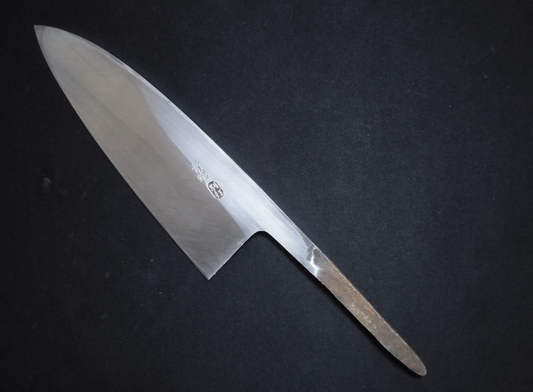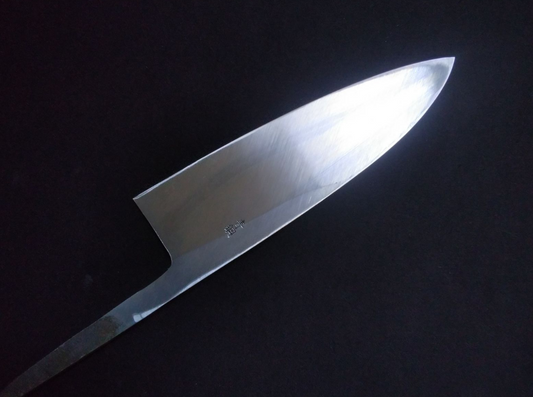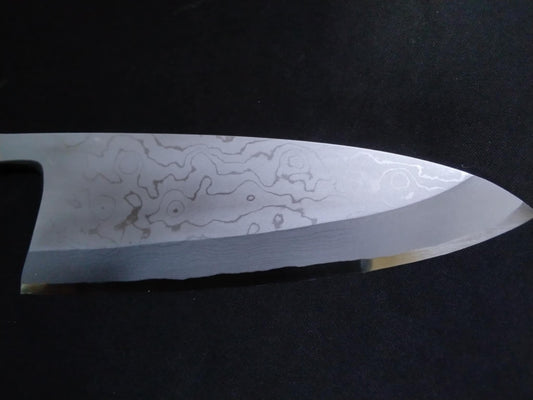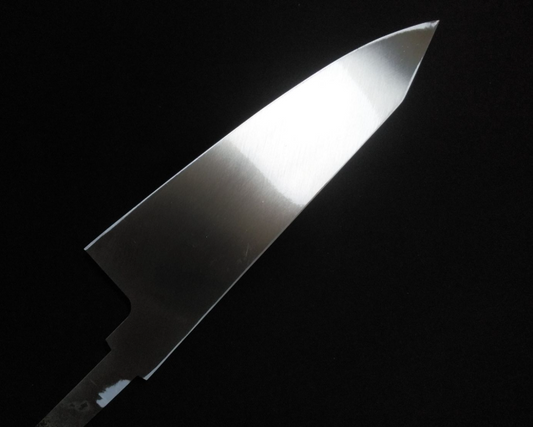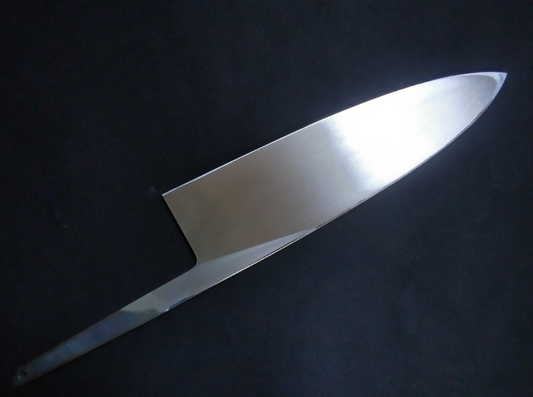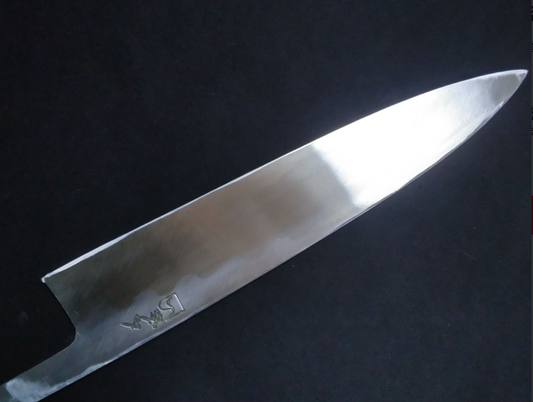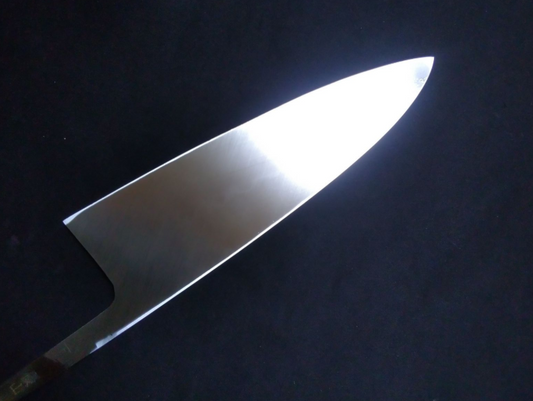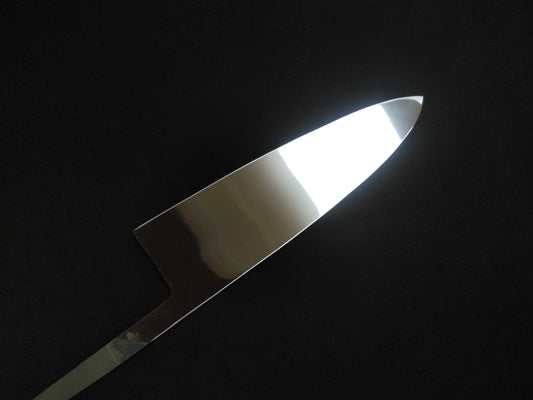
Deba
-
The Weight of Tradition in Your Hands
Heavy in hand, precise in action — the Deba transforms the art of preparing fish. Forged through centuries of tradition, it turns every cut into an act of respect and skill.
-
Deba Japanese Knife Collection
-
White Steel #2 KoDeba(Small Deba) 90mm-Mirror Polished(one side)
Regular price $220.00 CADRegular priceUnit price / per$0.00 CADSale price $220.00 CAD -
Blue Steel #2 Deba 165mm- Kido Finishing
Regular price $310.00 CADRegular priceUnit price / per$0.00 CADSale price $310.00 CAD -
Blue Steel #2 Deba 165mm- Mirror Polished(one side)
Regular price $340.00 CADRegular priceUnit price / per$0.00 CADSale price $340.00 CAD -
White Steel #2 Damascus Deba 150mm-Mirror Polished Blur Finish
Regular price $346.00 CADRegular priceUnit price / per$0.00 CADSale price $346.00 CADSold out -
Ginsan Deba 180mm -Mirror Polished(both sides)
Regular price $403.00 CADRegular priceUnit price / per$0.00 CADSale price $403.00 CADSold out -
Ginsan Deba 210mm -Mirror Polished(one side)
Regular price $440.00 CADRegular priceUnit price / per$0.00 CADSale price $440.00 CADSold out -
White Steel #2 Damascus Deba 210mm-Mirror Polished Blur Finish
Regular price $460.00 CADRegular priceUnit price / per$0.00 CADSale price $460.00 CADSold out -
Blue Steel #2 Deba 240mm- Mirror Polished(one side)
Regular price $500.00 CADRegular priceUnit price / per$0.00 CADSale price $500.00 CAD -
White Steel #2 (Honyaki-Mizuyaki) Deba 180mm-Mirror Polished(one side)
Regular price $750.00 CADRegular priceUnit price / per$0.00 CADSale price $750.00 CADSold out -
Super Steel (Honyaki) Deba 210mm-Mirror Polished(both sides)
Regular price $774.00 CADRegular priceUnit price / per$0.00 CADSale price $774.00 CAD -
Blue Steel #2 (Honyaki-Mizuyaki) Deba 180mm -Mirror Polished(one side)
Regular price $880.00 CADRegular priceUnit price / per$0.00 CADSale price $880.00 CADSold out
KIREAJI's Three Promises to You
-

1. Forged in the Legacy of Sakai
From Sakai City—Japan’s renowned birthplace of professional kitchen knives—each blade is crafted by master artisans with over six centuries of tradition. Perfectly balanced, enduringly sharp, and exquisitely finished, every cut carries the soul of true craftsmanship.
-

2. Thoughtful Care for Everyday Use
Every knife includes a hand-fitted magnolia saya for safe storage. Upon request, we offer a complimentary Honbazuke final hand sharpening—giving you a precise, ready-to-use edge from day one.
-

3. A Partnership for a Lifetime
A KIREAJI knife is more than a tool—it is a lifelong companion. With our bespoke paid aftercare services, we preserve its edge and beauty, ensuring it remains as precise and dependable as the day it first met your hand.
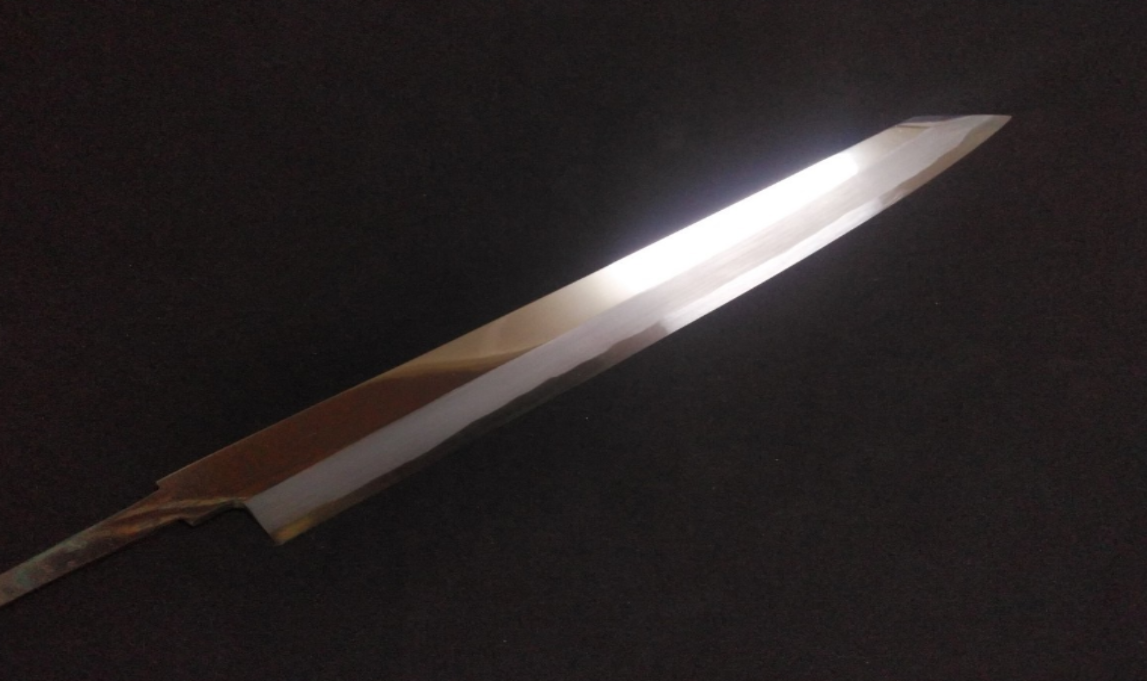
Why Many Product Photos Show Only the Blade
At KIREAJI, every knife is made to order in Sakai, Japan. Photos show the blade before the handle is attached, allowing artisans to perfect the balance and edge for your specific order. Your knife arrives fully finished — tailored just for you.

Global Delivery from Sakai
Across the world, discerning cooks seek authentic Japanese knives from Sakai — Japan’s legendary knife-making city with over 600 years of tradition.
At KIREAJI, we work alongside master artisans in Sakai to fulfill that desire, shipping genuine handcrafted knives directly from the workshop to kitchens worldwide.
Deba
-
Discovering the Deba — Understanding the Weight
When you first hold a Deba, one thing stands out immediately: its weight.
With a thick, wide blade and a solid, hefty feel, it may seem more like a small hatchet than a kitchen knife—especially if you're used to Western chef’s knives.But don’t be mistaken—this is not simply a heavy knife.
The Deba is a tool refined through centuries of Japanese culinary tradition, created for one purpose: to face the fish with respect, precision, and resolve.To hold a Deba is to engage in a kind of ritual. It’s not just cutting fish—it’s about entering a quiet battle where technique and respect are everything.
-

What Is a Deba?
The Deba is a traditional Japanese single-bevel knife designed specifically for preparing fish.
Its most distinctive features are its thick spine, broad blade, and single-edged design. These elements work together to let the knife cut cleanly through bones without cracking them, while also gliding smoothly along the fish’s skeleton to preserve delicate flesh.
Blade lengths usually range from 15cm to 21cm (6 to 8 inches).
Smaller Deba are used for river fish like ayu or small seabream, while larger versions are ideal for big fish like tuna or yellowtail.
In Japanese cooking, choosing the right size of Deba based on the fish is second nature. -
It’s Not Just “Cutting”—It’s Guiding the Blade
Unlike Western knives that are double-edged, the Deba is sharpened on only one side.
This single-bevel design allows the blade to "hug" the bones of the fish, making precise, fluid cuts with minimal resistance.When filleting a fish, the Deba’s edge feels like it speaks to the bone, telling you where to move.
As one instructor at my sushi school in Tokyo once said,
“Listen to the fish. The Deba will answer.”
At the time, it sounded poetic, maybe even a little silly. But years later, I understand exactly what he meant. -

Let the Knife Do the Work
One of the Deba’s signature traits is its weight.
But this isn’t a flaw—it’s a feature.Rather than forcing your way through a fish, you let the Deba’s own weight and gravity do the work.
When dropping the blade to remove a fish head, for example, it’s not about strength—it’s about angle, timing, and technique.Push too hard, and you’ll crack bones or chip the blade.
Use it right, and the Deba moves with quiet precision.This is the essence of Japanese knife philosophy:
The craftsman and the tool work together. -
Facing the Fish — Why the Deba Matters
The Deba is used at the very beginning of the cooking process—before heat, seasoning, or plating.
It’s at this stage that a dish’s entire character can be defined.
A clean fillet preserves texture. A poorly cut one bleeds flavor, ruins the structure, and wastes what could have been a perfect meal.In Western cuisine, heat often transforms the ingredient.
But in Japanese cuisine, the goal is to preserve the ingredient’s natural beauty and flavor. That’s why the knife is, in a sense, our “fire.”So the Deba is not just a knife—it’s a philosophy held in steel. It reflects how we approach food, respect life, and craft flavor from the very first cut.
-
In Conclusion: The Deba Is More Than a Tool
The Deba is not just a “fish knife.”
It is a manifestation of Japanese culinary philosophy, forged through centuries of discipline and aesthetic refinement.To hold one is to ask yourself:
“How do I choose to face the ingredients before me?”And in your answer, you will find yourself—not just a cook, but a craftsman.
Why the Deba Embodies Strength with Sensitivity
-

The Deba is defined by a rare balance: heavy enough to split bone, yet crafted to deliver precise, clean cuts that honor the fish. Its single-bevel geometry allows the blade to glide along the skeleton without waste, while its weight encourages technique over force. In skilled hands, the Deba becomes an instrument of power guided by sensitivity, revealing the philosophy that true mastery comes from letting the knife—and the ingredient—lead the way.
-
Why Are Deba Knives Thick? — Strength, Precision, and the Spirit of Japanese Craft
-
The Deba is one of Japan’s most iconic kitchen knives, instantly recognizable by its thick spine and solid weight. Far from being a design flaw, this bold profile is the result of centuries of refinement, allowing a single knife to move seamlessly from breaking down a whole fish to making delicate, glistening fillets.
-
1. Power Without Waste
When removing a fish’s head or working through joints, a thin blade can flex and waste energy. The Deba’s thick spine channels every bit of force directly to the cutting edge, delivering a decisive, clean cut through bone and cartilage without slipping or crushing the flesh.
-
2. Delicate Precision in a Heavy Frame
Despite its heft, the Deba’s edge is razor-thin and finely honed. This balance of mass and sharpness lets chefs transition effortlessly from heavy-duty work to precise, graceful filleting, all without changing tools.
-
3. Designed for the Challenges of Oily Fish
The Deba’s thickness allows for a deep ura-suki (hollow grind) on the back, reducing friction and preventing oily or fatty flesh from sticking. This means the blade glides smoothly, even through rich, slippery cuts like mackerel or yellowtail.
-
4. Tradition Meets Modern Demands
From the Edo period to today, the Deba has embodied the Japanese philosophy of “one knife for many tasks.” Its thick blade is not just about durability—it’s a statement of confidence that a single, perfectly balanced tool can serve both strength and subtlety in the kitchen.
-
To hold a Deba is to hold a piece of living tradition—a knife that carries the knowledge of generations, built to earn your trust with every cut.
Tracing the Roots of the Deba — A Knife Forged in Tradition, With a Wink of Humor
-
When you first pick up a Deba, you immediately feel its weight—solid, confident, unmistakably purposeful. This isn’t just a heavy kitchen tool. It’s the product of centuries of Japanese culinary wisdom, perfected for breaking down fish with both strength and finesse.
-

-
Born in Sakai — From Samurai Swords to Kitchen Blades
The Deba originated in the Edo period in Sakai, Osaka—a coastal city famed for blade-making. Once home to master swordsmiths, Sakai later became Japan’s heart of kitchen knife production. As fish became central to the Japanese diet, chefs needed a blade that could power through heads and bones, yet slice tender flesh cleanly. The Deba met that challenge—and its design has remained virtually unchanged for centuries, because it simply works.
-

-
A Name With a Smile
While “Deba” sounds serious, one playful theory about its name is anything but. Legend says the first craftsman to forge it had a pronounced overbite, nicknamed deppa in Japanese (“de” = stick out, “ha” = tooth). Over time, the knife took on a name that nodded to both the man and his craft. Is it true? Probably not. Is it still retold with a grin by chefs? Absolutely.
-
Precision, Heritage, and Humanity
Like all great Japanese tools, the Deba is built with discipline and precision—but also carries the warmth of the people who make and use it. Every time you hold one, you’re not just preparing fish. You’re holding a piece of history—shaped by skill, guided by tradition, and remembered with a touch of humor.
Deba: A Knife Rooted in Craft, Culture, and Human Story
-

The Deba reflects centuries of craftsmanship and culture, balancing power, precision, and a touch of human history.
-
FAQ About Deba
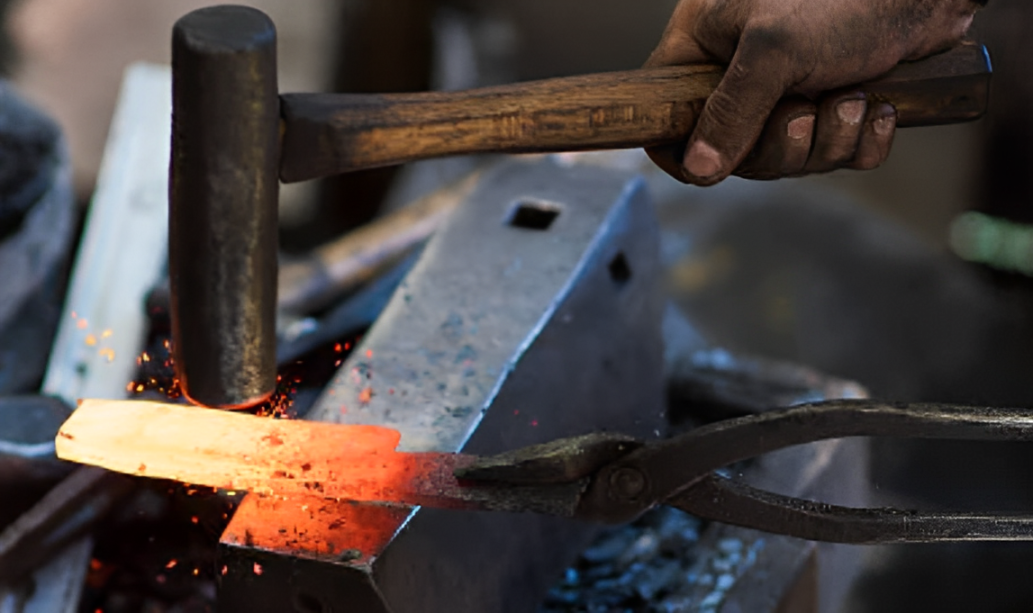
Q1. What is a Deba knife used for?
The Deba (出刃) is a traditional Japanese kitchen knife primarily designed for butchering fish. Its thick, heavy blade allows it to cut through fish heads and small bones with ease, while the razor-sharp edge ensures clean filleting without damaging delicate flesh. In addition to fish, the Deba can also be used for breaking down poultry or other small animals, though it is not intended for chopping large, hard bones.
Q2. What are the key features of a Deba knife?
The Deba is characterized by its thick spine, robust weight, and single-bevel edge. Its design combines strength with sharpness, enabling both power cuts and precise filleting. The blade length typically ranges from 150mm to 210mm, with smaller versions for home kitchens and larger ones for professional chefs.
Q3. Can a Deba be used for meat or poultry?
Yes, but with caution. While the Deba can handle poultry joints or small bones, it is not designed for large bones or hard chopping. For general meat preparation, a Gyuto or Western-style chef’s knife is more suitable. The Deba should be reserved for tasks where precision and controlled force are required.
Q4. How is the Deba different from a Garasaki or Gyuto?
The Deba is a specialist knife, not a general-purpose one. Compared to the Garasaki, which is tailored for poultry, the Deba is heavier and optimized for fish butchery, particularly for cutting through heads and bones. Unlike the Gyuto, which is versatile across many ingredients, the Deba is best reserved for tasks requiring strength and precision with fish.
Q5. Is the Deba single-edged or double-edged?
Traditionally, the Deba is single-beveled (kataba), which allows for precise, clean cuts and efficient filleting. This requires more skill to use and sharpen, but the payoff is unparalleled control. Some modern versions are made double-beveled (ryōba) for easier use in home kitchens and by left-handed users.
Q6. Is the Deba difficult to master?
Yes. Due to its weight, thickness, and single-bevel design, the Deba requires proper technique and practice to handle safely and effectively. Beginners may find it challenging at first, but with training, it becomes an indispensable tool for traditional Japanese cuisine. Mastering the Deba is often considered a milestone in a chef’s journey.
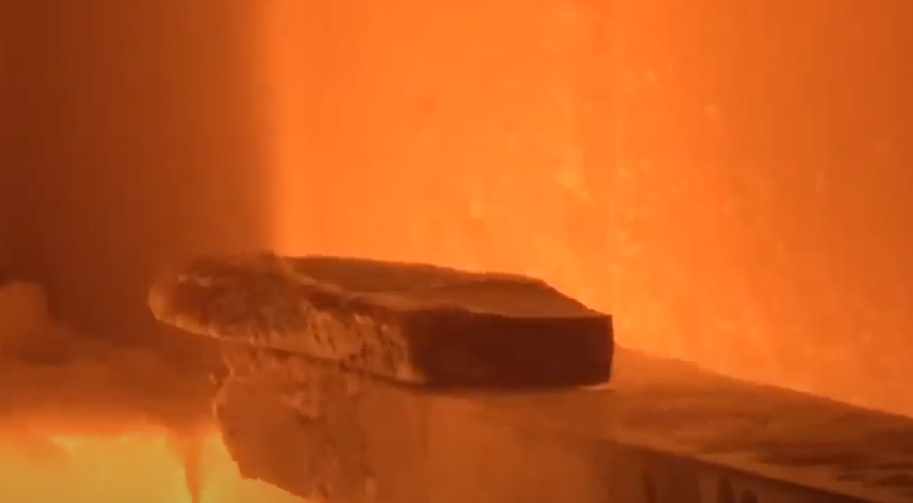
The Soul of Craftsmanship
-
Nurturing the Handle — Where Craft and Care Become One
The handle of a deba knife is where the greatest pressure gathers. Each time it cuts through fish and bone, immense force is focused here. For that reason, the handle is not just wood—it is the lifeline that connects blade and hand. Even the smallest cracks or splits must not be ignored, for moisture can creep in, rusting the internal tang and silently shortening the life of your knife.
-
Treat your knife not as something to ‘use and discard,’ but as a tool to nurture and maintain. If you notice any irregularities, don’t hesitate to consult a professional knife craftsman. That small bit of effort can ensure your knife remains a reliable extension of your hand for years to come. This is a tool imbued with both the craftsmanship of the maker and the care of the user—treat it with the respect it deserves.
-
Every knife carries two kinds of dedication: the soul of the maker who forged it, and the care of the person who uses it. The handle is where those two meet. Treat it with respect, and your knife will remain a true extension of your hand, a lifelong partner in your craft.
How Japanese Knives Are Made: The Sakai Tradition
VIDEO PROVIDED: JAPAN TRADITIONAL CRAFTS AOYAMA SQUARE (YOUTUBE)
-
Sakai Forged Blades — Six Centuries of Unrivaled Craftsmanship
Loved by chefs around the world and trusted by 98% of Japan’s top culinary professionals, Sakai knives are more than tools—they are the living legacy of over 600 years of master craftsmanship.
-
At KIREAJI, we work directly with the Shiroyama Knife Workshop in Sakai, Japan, ensuring every blade is hand-forged, finished to perfection, and shipped straight from the workshop to kitchens across the globe. No middlemen. No mass production. Only authentic, artisan-made knives, crafted to elevate your cooking for a lifetime.




